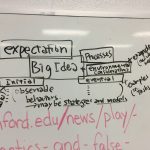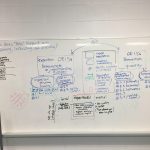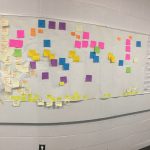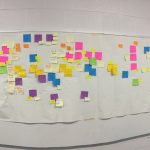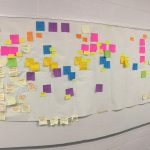Our team had the desire to delve deeper into the kindergarten program document with a specific focus on mathematics. The goal was to create a well-balanced and organized learning continuum that would serve to support educator teams. The continuum would directly support educators while planning and assessing, and responding to students’ needs, as well as the differentiation of instruction. As a team, we explored the resource What to Look For by Alex Lawson. This resource allowed us to build our mathematical understanding while relating and reflecting on our own classroom experiences. Through the process of building our two-year continuum, we were able to cluster concepts together in order to scaffold learning while also addressing developmental readiness for learning these mathematical concepts. In order to assist educators, we also focused on where students may initially be in terms of their understanding to where we hope they eventually will be with intentional interactions and other learning opportunities. With the support of our math and early years consultants, we successfully developed a useful working document. Although our intent was to create a continuum which included all areas of the math program we had to focus on number sense and measurement due to time constraints.
Team Members
Dara Krackovitch
York Region District School Board
Marci Adler
York Region District School Board
Angelica Napoli
York Region District School Board
Lyndsy Moffitt
York Region District School Board
Sandra Foryszewski
York Region District School Board
Hilary Starkman
York Region District School Board
Professional Learning Goals
Throughout this project, we were able to increase our professional knowledge of the Kindergarten Program Document. As our understanding deepened, we were able to select many mathematical concepts that could be clustered together to enhance student learning. In addition, our discussions and reflections led us to identify a sequence that would be most beneficial and based on students’ developmental readiness. Many team members were able to gain a better perspective on what initial learning may look like, as well as the eventual learning goals at the end of the two-year time frame. With the deepening of our knowledge, we also were able to achieve the goal of creating a comprehensive list of learning tools and models that would best suit instructional practices, student exploration and mathematical learning. With the use of several planned release opportunities, we successfully met another learning goal. The goal was to strengthen and continue to build a collaborative learning community among all members of the team. This goal included our DECE partners and building capacity with them as well. Our administration and math consultants supported this project and assisted us in gaining release time for our DECE partners to join us on this learning journey. Together, we created purposeful, focused collaboration sessions with rich dialogue that pushed all levels of knowledge forward. We are proud to report that we were able to meet all of our learning goals that we set at the onset of the project.
Activities and Resources
We began this learning journey with a simple conversation: How can we assess and support children in the new two-year kindergarten program in a responsive and developmental appropriate manner? As a team, we engaged in a professional conversation about the then 2011 draft version of the Kindergarten Document with a curriculum consultant. At this meeting, we decided that we needed to explore the document in depth and, at the same time, develop a visual continuum that aligns with the document, while incorporating the collective knowledge and experience of the educators (teachers and DECEs) with the young learners at the centre of our inquiry. In order to support this ongoing learning, we decided to apply for the TLC funding and started our collaborative inquiry this year.
We used What to Look For (Lawson) to give us a starting point and to help develop a common knowledge. The TLC team committed to explore this book in a monthly book study, where the members could discuss new insights, ask questions, and develop new ideas to be used in the classrooms. The curriculum document was further explored and unpacked, through professional dialogues, to gain a deeper knowledge and understanding of the new program. At this time, we have created a draft version of our visual two-year learning continuum (unpack expectations, place them on a timeline, include activities and models and tools required), using our own time. We’ve decided that this continuum will be the centrepiece of our TLC, and we will continue to construct this continuum during school based Professional Learning Teams (embedded learning opportunities) times during which we were able to include our DECE partners as part of the TLC learning. We continued to work on this continuum as a whole team and/or in small groups using our personal time as well.
In March, the team extended an invitation to our curriculum department to join us in this learning opportunity. Two consultants (math, early years) joined us on our release days and facilitated our continuous dialogue around the developmental nature of the Kindergarten Program. We covered a wide range of topics during our learning: discussion about play-based learning, developmental trajectories by Clement, the importance of spatial reasoning in the early years, the impact of language in learning mathematics, early number concepts and other content learning, and pedagogical documentation and assessment. During this learning, we decided that we will need to venture beyond our original visual continuum and explore each expectation in depth by outlining the conceptual understanding as well as the impact of educators’ intentional interaction have in moving students from their initial understanding/behaviours to meeting those learning goals outlined in the document.
At this time, we have created a digital version of our visual continuum, as well as a companion document organized by expectations (two out of five are completed; while others are in progress. All were uploaded to the TLC site), aimed to further outline what we have learned and hope to continue to learn about our program, our students and the learning trajectories in the early years.
Book: What to Look For by Alex Lawson
Book: Taking Shape: Activities to Develop Geometric and Spatial Thinking, Grades K-2 by Joan Moss, Catherine D. Moss, Bev Caswell, Tara Flynn and Zachary Hawes
Website: The Kindergarten Program 2016
Article: “Play, Mathematics, and False Dichotomies“ by Douglas H. Clements and Julie Sarama
Article: “Language of Learning” by Lisa Burman
Website: Learning Trajectories
Unexpected Challenges
The following areas/questions were unexpected challenges for us:
How do we organize the two-year continuum?
Our thinking shifted from organizing the expectations linearly to clustering expectations that addressed a big idea.
How do we use the two-year continuum to inform planning, instruction and assessment?
How do we create a common understanding and messaging about content and implementation of the two-year continuum?
We developed a list of look-fors for each big idea in the kindergarten curriculum to support planning, instruction and assessment. We spent a lot of time looking at the look-fors and made sure that we all had a common understanding of them and that they were developmentally appropriate for our learners. We shared personal experiences in the classroom with one another to attain this goal.
How do we utilize our time effectively to co-develop the two-year continuum while gaining a deeper understanding of the math curriculum in kindergarten?
We used PLT time, staff meetings, PA Days and professional development that supported the process. We had to manage our time and keep each other on task so that we could gain the most out of our conversations with one another.
How do we continue to deepen our learning of two-year continua in patterning, data management, geometry and spatial sense?
We plan on continuing to meet and have conversations about what students should say, do and represent within our math program, initially as well as eventually.
How do we ensure that admin supports the release of the team so that they understand the importance of having more time to work on our project?
We plan to share the work we have done during this project with our admin so that they can gain a deeper understanding of how the continua that we created can better support us and our students in our inquiry-based programs. We had admin drop in for a brief visit while we were working on our project so that they could see the process in action.
Enhancing Student Learning and Development
We believe that this project can enhance student learning and development in a number of ways. The list of intentional interactions that we have compiled for each overall expectation will support educators in helping students move from their initial understandings to our proposed eventual understandings. These intentional interactions have been well-thought-out so that they can easily be integrated into daily routines. The intentional interactions will lead to our students’ environment and daily routines being mathemetized in well-thought-out ways. Students will be more engaged in mathematical learning as we now have a number of new ideas for tasks and experiences that can be integrated into the students’ zones of proximal developments. The project honours the power of play and inquiry in kindergarten; math is everywhere! The project will also lead to students being exposed to a variety of mathematical models and tools to help develop their understandings of how and when to use them.
The continuum allows us to consider this very important question: “Why this task for this child at this time?” As educators gain a deeper understanding of the mathematical concepts by referring to the continuum, they will be able to better provide their students with rich, meaningful tasks that are developmentally appropriate. The continuum will support educators in creating meaningful next steps for student learning. The intentional interactions can also be shared with families (e.g., newsletters, math nights, etc.) and this will support student learning at home; shifting traditional ideas of “homework.”
In summary, by utilizing the continuum, we will be able to ensure that our mathematical provocations, tasks and lessons will be specific to each child’s specific strengths, interests and needs and this will in turn enhance the learning and development of all of our students.
Sharing
As we worked through this process, we were proud to share our learning with our administrators through the Google Drive platform. They were able to follow along on our journey and see the progress over time.
We would like to further share our learning process with our entire school staff during staff meetings. The process of creating our continuum and the learning, growth and successes as a team were a valuable process which we feel could also be shared through our Professional Learning Teams. We hope to share our learning while supporting other teams who embark on a similar journey within the primary grades. As we continue to work through our continuum plan, we hope to invite board representatives into our classrooms to see our work and how it is being implemented into our daily classroom activities. To inform our parent community about this continuum learning process, we would like to share our learning during a kindergarten math night, a curriculum night, as well as through newsletters and detailed documentation of student learning during play.
After the final completion and implementation of our continuum, our future plans would be to start networking with other schools and demonstrating how we put our work into action in our classrooms (e.g., inviting them into our classrooms, workshops, presentations).
Project Evaluation
At the inception of the project, we loosely based our project on these criteria:
- Physical creation of a two-year learning continuum
- Use the working document to guide math instruction and modify based on the success and reflection of the practical application
- Built capacity within our team members which will be evident in the deeper conversations that take place with more understanding and confidence
- Working in conjunction with math and early years consultants will validate that we have met our goal as we will know that our work has been supported by their knowledge of best practices in kindergarten and math.
In relation to the “physical creation of a two-year learning continuum,” we have successfully created a draft version of our two-year learning continuum that went through several iterations (visuals are included). The document successfully supports and drives our ongoing conversations around the professional understanding of the contents, assessment practices, and instructional tools/strategies. As a result, we embarked on creating a digital component which outlines the expectations, conceptual understandings and further explains student growths from initial behaviours to eventual ones. We felt that the original document is a success because we were able to find alignments between the Kindergarten Document, the digital components and the original continuum that we first created.
In relation to “use the working document to guide math instruction and modify based on the success and reflection of the practical application,” we realized that we did not explicitly use this document throughout the TLC learning when teaching and learning with our young learners. However, we were aware of the moments when we made connections to the document (and the learning conversations while building the continuum) while observing our learners on a daily basis. In retrospect, we would make sure that each educator in this project have a copy of the document (even in draft form) in the classroom, so we can document these connections and aha moments as they occur.
In relation to “built capacity within our team members which will be evident in the deeper conversations that take place with more understanding and confidence,” we experienced most success in this area of our learning goals, based on the personal reflections (verbal) provided by all participating educators. Participants have expressed the following:
- “This experience has been valuable in supporting our long-range planning…”
- “Looking into the curriculum further was very helpful as well as having the time to sit down and collaborate”
- “Having the support of our consultants was beneficial in driving our learning”
- “I feel that we have done a lot of ‘connecting the dots’ … these (tasks, activities, etc.) are making sense now as a whole”
- “As the DECE on the team, I can say that we felt included and valued as a part of this learning….”
- “This process deepened our understanding of the math curriculum in kindergarten to support planning, instruction and assessment”
- “Having collaborative time to engage in dialogue with colleagues was amazing since this is something we never have time to do”
- “We learned more about the content”
- “Changed our perception about kindergarten mathematics and the movement from initial to eventual behaviours”
- “Sharpened our focus for pedagogical documentation”
In relation to “working in conjunction with math and early years consultants will validate that we have met our goal as we will know that our work has been supported by their knowledge of best practices in kindergarten and math,” we worked closely with the curriculum team throughout the learning process. We were able to have meaningful conversations that pushed our learning forward and share experiences that brought more life to the knowledge we were building together. We plan to continue this process with the valuable support and expertise of our consultants.
Resources Used
Learning Trajectories: a web-based tool for early childhood educators to learn about how children think and learn about mathematics and how to teach mathematics to young children
The Kindergarten Program: 2016
https://files.ontario.ca/books/edu_the_kindergarten_program_english_aoda_web_july21.pdf
“Language of Learning”
Taking Shape: Activities to Develop Geometric and Spatial Thinking, Grades K-2 by Joan Moss, Catherine D. Moss, Bev Caswell, Tara Flynn and Zachary Hawes. Toronto: Pearson Canada, 2016.
This book explores spatial reasoning as integral and foundational to math understanding. It provides a look at the key themes within spatial reasoning and includes many tasks, games and challenges to support the many themes.
What to Look For: Understanding and Developing Student Thinking in Early Numeracy by Alex Lawson. Toronto: Pearson Canada, 2016.
This book is based on the documentation and the analyzing of a student group and their mathematical progress over a number of years. It focuses on students’ strategies and key ideas and how they develop over time.
Resources Created
These resources will open in your browser in a new tab, or be downloaded to your computer.


